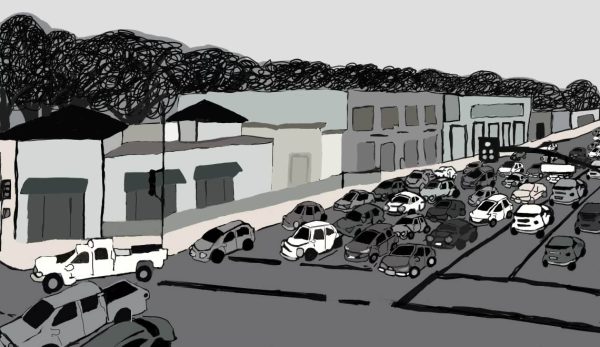Inflation Reduction, Claire-ified
At such a critical time, our nation cannot afford to ignore the present or avoid protecting the future.
August 24, 2022
There are few decisions as difficult to make as those regarding the current inflation crisis. Forming economic predictions during unprecedented times yields little that is concrete or easily interpretable, and even with that rickety foundation, choosing which bridge to cross feels impossible. The economy can be left to resolve itself, a choice that would risk infinite and debilitating price hikes. Alternatively, central banks can raise interest rates to make things like mortgages more expensive, discouraging spending and lowering demand to bring prices down — but risking a recession in doing so.
For a while, the choice seemed simple to financial policymakers: do nothing. They predicted that pandemic supply chain issues would resolve quickly enough to avoid any long-term damage and decided to weather what they thought was a fleeting storm. By now, however, economists have recognized that this was a faulty assumption. Prices of goods like gas, food, cars and gardening equipment are soaring — even the school’s tuition increased by over 4% this year to match inflation. These dramatic changes in cost made inaction dangerous. Policymakers had to leap, and they had to do it quickly.
The Federal Reserve, America’s central bank, raised interest rates at a pace more frequently than anything the nation has seen in decades, with Federal Reserve Chairman Jerome Powell promising a “soft-ish” landing from inflation. Powell’s clear lack of confidence made sense; even the most knowledgeable and influential economists cannot guarantee that such a sharp turn in monetary policy will avoid a recession. Lowering interest rates is still worth the risk because a large part of the current crisis can be attributed to sharply increasing demand. When consumers and corporations can and want to buy more products — a trend that has continued for years — prices rise, leading to inflation. A quick way to reduce inflation, therefore, is reducing this demand, however risky the process may be.
Luckily, the Fed is not the only tool Americans have to combat inflation. The president and Congress can issue executive orders and pass legislation, respectively, that will have massive deflationary effects over time. President Joe Biden removed a gas tax and negotiated with foreign oil providers to curb rising gas prices, which dropped significantly in July and August. But the most substantial policy measure was the Inflation Reduction Act, a massive bill that passed this month and addresses far more than inflation.
The bill includes a 15% minimum tax on all corporations worth more than one billion dollars, a change that will eliminate their ability to skirt taxes through loopholes. These companies will have to pay roughly 300 billion dollars in additional taxes over the next ten years, and this will significantly reduce the amount they are able to spend. Such a reduction will affect the demand side of inflation; with a smaller budget, large corporations will have to spend less.
But even after reigning in hundreds of billions of dollars, the bill will end up with a net zero inflation reduction. This is because it also dedicates over 300 billion dollars to creating climate-friendly infrastructure and technology, pumping more money into the economy at a time that, from a strictly inflation-based perspective, it is not ideal.
Democrats and the Biden administration are familiar with making economically unfortunate policy decisions that are crucial in the long term — the COVID-19 stimulus bill was a prime example. Americans needed stimulus cash to avoid what would have been the worst economic crisis in national history. In the case of climate legislation, avoiding deadly climate catastrophes is perhaps the most important choice the world will make in the coming decades.
It will also have deflationary impacts in the years to come, making it easier to meet the demand for green energy and technologies. Everything the Biden Administration and Congress have done in the past month was the right call from a long-term perspective. However, short-term inflation remains a real and painful problem for most of the country. There is no magic wand to wave away this problem, but aside from raising interest rates carefully, the best way to resolve inflation is to address the supply side of the curve.
While part of our current crisis comes from rising demand from consumers and businesses, it only becomes inflationary when it is met with insufficient supply. After lockdowns in key manufacturing countries set off global supply chain issues, the world is far behind on producing numerous key items. The war in Ukraine further exacerbated this issue. Creating goods and bringing them from one place to another gets more difficult by the month, and resolving this challenge is policymakers’ best bet at calming inflation. This will require numerous structural changes, including global efforts to reduce protectionism and facilitate trade and transportation between nations. It will also require attempts to localize production and transportation, along with expanding transportation facilities like ports.
Amid all of these intricate decisions about priorities and economic strategies, it is easy to wonder how the world is ever going to get out of this mess. Inflation is a terrifying Goliath that turns even the most powerful people on earth into Davids, and the truth is that none of this will ever be simple or easy. But it will be rewarding, only if America figures out how to leverage short-term problems and create both short- and long-term solutions through changes like the Inflation Reduction act, executive orders, logistical changes and monetary policy. At such a critical time, our nation cannot afford to ignore the present or avoid protecting the future. Governments have to weigh the magnitude and immediacy of problems they face, but the best they can do is make these considerations wisely. They might not have one stone powerful enough to knock out inflation, but they do have the world’s most powerful slings. All that is left to do is use them.





































